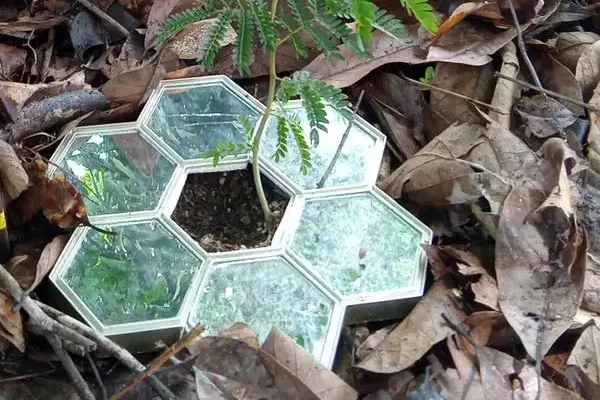The most endangered plant species in the Mariana Islands, the legume tree Serianthes nelsonii, faces persistent threats in its recovery. These have been identified as a short lifespan of habitat seedlings and rapid death of saplings transplanted from conservation nurseries.
The Plant Physiology Laboratory at the University of Guam addressed this conundrum by improving growth and survival of Serianthes seedlings through strategically placed mirrors beneath deeply shaded seedlings to increase available ambient light. The resulting paper has been published in the August issue of the journal Agronomy.
“We combined several known facts to develop the protocols,” said author Thomas Marler, retired University of Guam professor. “First, the amount of sunlight that penetrates to the sub-canopy is minimal in Guam’s karst forest communities, and adding available light by installing lamps above Serianthes seedlings can increase longevity. Second, colored plastic mulch has been exploited for decades to reflect sunlight to improve crop production systems.”
The innovative protocol evolved from the widespread use of black plastic mulch in many crop production systems. The pioneers of the technology in the 1980s embraced the fact that growers were going to use plastic mulch anyway, so why not try various colors as a means of managing beneficial plant responses? Improved production systems were developed for numerous crops and included increased yield and reduced pest damage.
“Our first conception was to mimic these vegetable production protocols by exploiting commercially available plastic colored mulch products,” Marler said. “Then we realized that costs associated with a reflective product were less limiting for small-scale tree conservation approaches than for large-scale crop production settings.”
This led the team to instead employ mirrors — the most reflective product available.
The study revealed that the light reflected from the mirrors was more than 70% of incoming ambient light at midday in some cases. This boost in available light energy led to profound plant responses, as seedling survival increased more than 160% and growth in plant height increased more than 170% in one of the experiments.
Conservation practitioners often lack the information needed to improve management strategies designed for recovery of endangered tree species. But this newly developed protocol is ideal for the plant conservation toolbox because costs are minimal and improving plant performance is probable for every application. More importantly, there are no downsides as risks of harming the managed plants with the new procedure are negligible.
Read the paper: Agronomy
Article source: University of Guam via EurekAlert
Image credit: The strategic placement of mirrors beneath Serianthes seedlings has been shown to boost available light and improve plant survival. Credit: Thomas Marler






